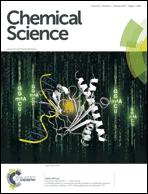We are delighted to announce that Chemical Science’s latest Impact Factor has soared to an impressive 9.211 this year, according to the 2014 Journal Citation Reports®.

Chemical Science became a gold open access journal in January 2015, giving the global community free access to high quality research while waiving all Article Processing Charges (APCs), keeping articles free to publish, for at least two years. This unique combination of open access, top quality articles, a flexible format and world-class Associate Editors makes it clear why so many leading scientists choose to publish in Chemical Science.
We invite you to submit your exceptional research to Chemical Science today.
Take a look at our most highly cited articles listed below.
Perspectives
Ruthenium-catalyzed direct oxidative alkenylation of arenes through twofold C–H bond functionalization
Sergei I. Kozhushkov and Lutz Ackermann
Chem. Sci., 2013, 4, 886-896
DOI: 10.1039/C2SC21524A, Perspective
Indole synthesis – something old, something new
Martyn Inman and Christopher J. Moody
Chem. Sci., 2013,4, 29-41
DOI: 10.1039/C2SC21185H, Perspective
Minireviews
Intriguing aspects of lanthanide luminescence
Jean-Claude G. Bünzli and Svetlana V. Eliseeva
Chem. Sci., 2013,4, 1939-1949
DOI: 10.1039/C3SC22126A, Minireview
Carbene-stabilized main group radicals and radical ions
Caleb D. Martin, Michele Soleilhavoup and Guy Bertrand
Chem. Sci., 2013,4, 3020-3030
DOI: 10.1039/C3SC51174J, Minireview
Edge articles
Slow magnetization dynamics in a series of two-coordinate iron(II) complexes
Joseph M. Zadrozny, Mihail Atanasov, Aimee M. Bryan, Chun-Yi Lin, Brian D. Rekken, Philip P. Power, Frank Neese and Jeffrey R. Long
Chem. Sci., 2013, 4, 125-138
DOI: 10.1039/C2SC20801F, Edge Article
Metal-free oxidative tandem coupling of activated alkenes with carbonyl C(sp2)–H bonds and aryl C(sp2)–H bonds using TBHP
Ming-Bo Zhou, Ren-Jie Song, Xuan-Hui Ouyang, Yu Liu, Wen-Ting Wei, Guo-Bo Deng and Jin-Heng Li
Chem. Sci., 2013,4, 2690-2694
DOI: 10.1039/C3SC50810B, Edge Article
Catalytic hydrotrifluoromethylation of styrenes and unactivated aliphatic alkenes via an organic photoredox system
Dale J. Wilger, Nathan J. Gesmundo and David A. Nicewicz
Chem. Sci., 2013,4, 3160-3165
DOI: 10.1039/C3SC51209F, Edge Article
Read more Impact Factor highlights for the Royal Society of Chemistry’s leading journals, including Chemical Communications and Chemical Society Reviews.
Find out how other RSC journals are ranked in the latest Impact Factor release
Chemical Science is the world’s first high-quality gold open access chemistry journal (open access from January 2015). Set up a personal account on the publishing platform to download articles for free.
*The Impact Factor provides an indication of the average number of citations per paper. Produced annually, Impact Factors are calculated by dividing the number of citations in a year, by the number of citeable articles published in the preceding two years. Data based on 2014 Journal Citation Reports®, (Thomson Reuters, 2015).










